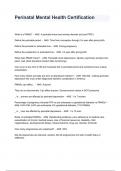Exam (elaborations)
Perinatal Mental Health Exam Questions And Answers
- Course
- Institution
Perinatal Mental Health Exam Questions And Answers What is a PMAD? - ANS A perinatal mood and anxiety disorder (not just PPD!) Define the perinatal period. - ANS Time from conception through 1st year after giving birth. Define the prenatal or antenatal time - ANS During pregnancy ...
[Show more]



